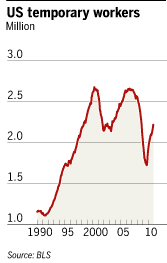- You are here:
- Home »
- Changing Legal Landscape »
- A structural shift: temps as a permanent solution
A structural shift: temps as a permanent solution
9 December 2010 — As the U.S. economy shows a slight pick up in activity, companies have started to hire temporary workers. But with a difference. After the trials and tribulations of being forced to lay off people during the recession, many companies do not plan to use temporary workers just for the recovery’s shaky beginnings – they plan to keep a large percentage of their workforce temporary permanently.
Last week’s payroll data was grim — the unemployment rate rose to a seven-month high of 9.8 per cent. But they also showed that the number of temporary workers continued to climb in the US last month. The economy added 40,000 temporary workers in November while the total workforce expanded by 39,000. Since temporary work reached its recent low in September 2009, 494,000 temporary jobs have been added, compared with an increase of 901,000 positions in the same period.
Welcome to a structural shift, say the economists. Temporary workers will be making up a larger proportion of the labor force. Temporary employment is usually one step towards a permanent hire but this time around the use of temp workers looks a bit more permanent.
This “resizing” of the economy includes the legal profession. The recent Hildebrandt survey of the legal industry, the National Law Journal survey and ALM survey all showed a significant increase in “other” attorneys, defined as nonpartner and nonassociate lawyers. Most of those surveys include temporary or contract attorneys.
As we had previously reported, we heard from the temporary attorney war rooms that during the recession, in order to keep the troops busy, law firms gave their associates work that would have normally gone to contract attorneys. But now, even as the economy continues to improve, the ranks of “other” attorneys continue to swell due to their lower cost and often more targeted experience. We have seen that as many contract attorneys with specialized experience move out of the document review rooms and into more substantive work.
And — surprise! — employment agencies will be one major beneficiary of this change. Kelly Services has so far seen a 20-25 per cent rise in people placed in temporary work, compared to last year, a big chunk coming from the Kelly Law division. Speaking about an across-the-board trend Carl Camden, chief executive of Kelly Services, was quoted as saying he thinks the temporary portion of the workforce will be higher at the top of this cycle than it was at the peak of the last: “Chief executives around the world often say to me they had too high of a proportion of fixed rather than variable labor costs. I see a pretty strong commitment by management to increase the proportion that are variable.”
The FT recently chronicled the story of Stacey Mungo, a lawyer who started working on a temporary basis through Kelly Legal Services after she lost her job in a bank merger. She plans to stick with temporary work because it enables her to work closer to home, giving her more time with her nine-year-old son.
Yes, the downside. It is not the same pay as her full time job. But, she’s working. And the adjustment is necessary. Anthony Carnevale, director of the Georgetown University Center on Education and the Workforce, says this recovery is continuing the pattern of the last two by making more and more jobs temporary: “Employers have shifted risk to employees and as many other employers as they can. What the system has learned to do is to be enormously more productive,” he said. “If you think this is temporariness you haven’t seen anything yet.”
Shocking. It’s all about money.

